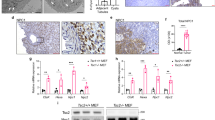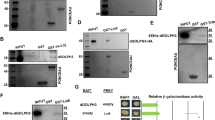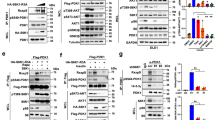Abstract
The direct mechanism by which the serine/threonine kinase Akt (also known as protein kinase B (PKB)) regulates cell growth is unknown. Here, we report that Drosophila melanogaster Akt/PKB stimulates growth by phosphorylating the tuberous sclerosis complex 2 (Tsc2) tumour suppressor and inhibiting formation of a Tsc1–Tsc2 complex. We show that Akt/PKB directly phosphorylates Drosophila Tsc2 in vitro at the conserved residues, Ser 924 and Thr 1518. Mutation of these sites renders Tsc2 insensitive to Akt/PKB signalling, increasing the stability of the Tsc1–Tsc2 complex within the cell. Stimulating Akt/PKB signalling in vivo markedly increases cell growth/size, disrupts the Tsc1–Tsc2 complex and disturbs the distinct subcellular localization of Tsc1 and Tsc2. Furthermore, all Akt/PKB growth signals are blocked by expression of a Tsc2 mutant lacking Akt phosphorylation sites. Thus, Tsc2 seems to be the critical target of Akt in mediating growth signals for the insulin signalling pathway.
This is a preview of subscription content, access via your institution
Access options
Subscribe to this journal
Receive 12 print issues and online access
$209.00 per year
only $17.42 per issue
Buy this article
- Purchase on SpringerLink
- Instant access to full article PDF
Prices may be subject to local taxes which are calculated during checkout








Similar content being viewed by others
References
Gomez, M. R., Sampson, J. R. & Whittemore, V. H. Tuberous Sclerosis Complex (Oxford University Press, New York, 1999).
Gomez, M. R. Tuberous Sclerosis (Raven Press, New York, 1988).
van Slegtenhorst, M. et al. Identification of the tuberous sclerosis gene TSC1 on chromosome 9q34. Science 277, 805–808 (1997).
Consortium, T. E. C. T. S. Identification and characterization of the tuberous sclerosis gene on chromosome 16. Cell 75, 1305–1315 (1993).
Maheshwar, M. M. et al. The GAP-related domain of tuberin, the product of the TSC2 gene, is a target for missense mutations in tuberous sclerosis. Hum. Mol. Genet. 6, 1991–1996 (1997).
Cheadle, J. P., Reeve, M. P., Sampson, J. R. & Kwiatkowski, D. J. Molecular genetic advances in tuberous sclerosis. Hum. Genet. 107, 97–114 (2000).
Lupas, A., Van Dyke, M. & Stock, J. Predicting coiled coils from protein sequences. Science 252, 1162–1164 (1991).
van Slegtenhorst, M. et al. Interaction between hamartin and tuberin, the TSC1 and TSC2 gene products. Hum. Mol. Genet. 7, 1053–1057 (1998).
Plank, T. L., Yeung, R. S. & Henske, E. P. Hamartin, the product of the tuberous sclerosis 1 (TSC1) gene, interacts with tuberin and appears to be localized to cytoplasmic vesicles. Cancer Res. 58, 4766–4770 (1998).
Nellist, M. et al. Characterization of the cytosolic tuberin–hamartin complex. Tuberin is a cytosolic chaperone for hamartin. J. Biol. Chem. 274, 35647–35652 (1999).
Miloloza, A. et al. The TSC1 gene product, hamartin, negatively regulates cell proliferation. Hum. Mol. Genet. 9, 1721–1727 (2000).
Xu, T., Wang, W., Zhang, S., Stewart, R. A. & Yu, W. Identifying tumor suppressors in genetic mosaics: the Drosophila lats gene encodes a putative protein kinase. Development 121, 1053–1063 (1995).
Theodosiou, N. A., Zhang, S., Wang, W. Y. & Xu, T. slimb coordinates wg and dpp expression in the dorsal–ventral and anterior–posterior axes during limb development. Development 125, 3411–3416 (1998).
Ito, N. & Rubin, G. M. gigas, a Drosophila homolog of tuberous sclerosis gene product-2, regulates the cell cycle. Cell 96, 529–539 (1999).
Huang, H. et al. PTEN affects cell size, cell proliferation and apoptosis during Drosophila eye development. Development 126, 5365–5372 (1999).
Oldham, S., Montagne, J., Radimerski, T., Thomas, G. & Hafen, E. Genetic and biochemical characterization of dTOR, the Drosophila homolog of the target of rapamycin. Genes Dev. 14, 2689–2694 (2000).
Gao, X., Neufeld, T. P. & Pan, D. Drosophila PTEN regulates cell growth and proliferation through PI3K-dependent and -independent pathways. Dev. Biol. 221, 404–418 (2000).
Potter, C. J., Huang, H. & Xu, T. Drosophila Tsc1 functions with Tsc2 to antagonize insulin signaling in regulating cell growth, cell proliferation, and organ size. Cell 105, 357–368 (2001).
Tapon, N., Ito, N., Dickson, B. J., Treisman, J. E. & Hariharan, I. K. The Drosophila tuberous sclerosis complex gene homologs restrict cell growth and cell proliferation. Cell 105, 345–355 (2001).
Gao, X. & Pan, D. TSC1 and TSC2 tumor suppressors antagonize insulin signaling in cell growth. Genes Dev. 15, 1383–1392 (2001).
Moberg, K. H., Bell, D. W., Wahrer, D. C., Haber, D. A. & Hariharan, I. K. Archipelago regulates Cyclin E levels in Drosophila and is mutated in human cancer cell lines. Nature 413, 311–316 (2001).
Goberdhan, D. C., Paricio, N., Goodman, E. C., Mlodzik, M. & Wilson, C. Drosophila tumor suppressor PTEN controls cell size and number by antagonizing the Chico/PI3-kinase signaling pathway. Genes Dev. 13, 3244–3258 (1999).
Maehama, T. & Dixon, J. E. The tumor suppressor, PTEN/MMAC1, dephosphorylates the lipid second messenger, phosphatidylinositol 3,4,5-trisphosphate. J. Biol. Chem. 273, 13375–13378 (1998).
Cantley, L. C. & Neel, B. G. New insights into tumor suppression: PTEN suppresses tumor formation by restraining the phosphoinositide 3-kinase/AKT pathway. Proc. Natl Acad. Sci. USA 96, 4240–4245 (1999).
Lehner, C. F. The beauty of small flies. Nature Cell Biol. 1, E129–E130 (1999).
Edgar, B. A. From small flies come big discoveries about size control. Nature Cell Biol. 1, E191–E193 (1999).
Weinkove, D. & Leevers, S. J. The genetic control of organ growth: insights from Drosophila. Curr. Opin. Genet. Dev. 10, 75–80 (2000).
Stocker, H. & Hafen, E. Genetic control of cell size. Curr. Opin. Genet. Dev. 10, 529–535 (2000).
Alessi, D. R. & Cohen, P. Mechanism of activation and function of protein kinase B. Curr. Opin. Genet. Dev. 8, 55–62 (1998).
Brazil, D. P. & Hemmings, B. A. Ten years of protein kinase B signalling: a hard Akt to follow. Trends Biochem. Sci. 26, 657–664 (2001).
Scheid, M. P. & Woodgett, J. R. PKB/AKT: functional insights from genetic models. Nature Rev. Mol. Cell Biol. 2, 760–768 (2001).
Verdu, J., Buratovich, M. A., Wilder, E. L. & Birnbaum, M. J. Cell-autonomous regulation of cell and organ growth in Drosophila by Akt/PKB. Nature Cell Biol. 1, 500–506 (1999).
Shioi, T. et al. Akt/protein kinase B promotes organ growth in transgenic mice. Mol. Cell. Biol. 22, 2799–2809 (2002).
Stambolic, V. et al. Negative regulation of PKB/Akt-dependent cell survival by the tumor suppressor PTEN. Cell 95, 29–39 (1998).
Aoki, M., Blazek, E. & Vogt, P. K. A role of the kinase mTOR in cellular transformation induced by the oncoproteins P3k and Akt. Proc. Natl Acad. Sci. USA 98, 136–141 (2001).
Alessi, D. R., Caudwell, F. B., Andjelkovic, M., Hemmings, B. A. & Cohen, P. Molecular basis for the substrate specificity of protein kinase B; comparison with MAPKAP kinase-1 and p70 S6 kinase. FEBS Lett. 399, 333–338 (1996).
Brand, A. H. & Perrimon, N. Targeted gene expression as a means of altering cell fates and generating dominant phenotypes. Development 118, 401–415 (1993).
Scanga, S. E. et al. The conserved PI3′K/PTEN/Akt signaling pathway regulates both cell size and survival in Drosophila. Oncogene 19, 3971–3977 (2000).
Ito, K., Awano, W., Suzuki, K., Hiromi, Y. & Yamamoto, D. The Drosophila mushroom body is a quadruple structure of clonal units each of which contains a virtually identical set of neurones and glial cells. Development 124, 761–771 (1997).
Struhl, G. & Basler, K. Organizing activity of wingless protein in Drosophila. Cell 72, 527–540 (1993).
Schmelzle, T. & Hall, M. N. TOR, a central controller of cell growth. Cell 103, 253–262 (2000).
Dufner, A. & Thomas, G. Ribosomal S6 kinase signaling and the control of translation. Exp. Cell Res. 253, 100–109 (1999).
Bunch, T. A., Grinblat, Y. & Goldstein, L. S. Characterization and use of the Drosophila metallothionein promoter in cultured Drosophila melanogaster cells. Nucleic Acids Res. 16, 1043–1061 (1988).
Halder, G. et al. Eyeless initiates the expression of both sine oculis and eyes absent during Drosophila compound eye development. Development 125, 2181–2191 (1998).
Hay, B. A., Maile, R. & Rubin, G. M. P element insertion-dependent gene activation in the Drosophila eye. Proc. Natl Acad. Sci. USA 94, 5195–5200 (1997).
Zhang, H., Stallock, J. P., Ng, J. C., Reinhard, C. & Neufeld, T. P. Regulation of cellular growth by the Drosophila target of rapamycin dTOR. Genes Dev. 14, 2712–2724 (2000).
Fehon, R. G. et al. Molecular interactions between the protein products of the neurogenic loci Notch and Delta, two EGF-homologous genes in Drosophila. Cell 61, 523–534 (1990).
Acknowledgements
We thank K. Wehner for helpful discussions, M. Birnbaum for Dakt1 reagents, the Developmental Studies Hybridoma bank for anti-gigas antibodies and X. Fei for injections. This work was supported in part by a National Institutes of Health grant (CA69408) and the Rothberg Courage Award, TS Alliance. T.X. is an investigator of the Howard Hughes Medical Institute. C.J.P. was a predoctoral candidate in the Department of Genetics.
Author information
Authors and Affiliations
Corresponding author
Ethics declarations
Competing interests
The authors declare no competing financial interests.
Supplementary information
Supplementary figure
Figure S1. Akt expression does not enhance the Tsc1 mutant phenotype. (PDF 170 kb)
Rights and permissions
About this article
Cite this article
Potter, C., Pedraza, L. & Xu, T. Akt regulates growth by directly phosphorylating Tsc2. Nat Cell Biol 4, 658–665 (2002). https://doi.org/10.1038/ncb840
Received:
Revised:
Accepted:
Published:
Issue Date:
DOI: https://doi.org/10.1038/ncb840



